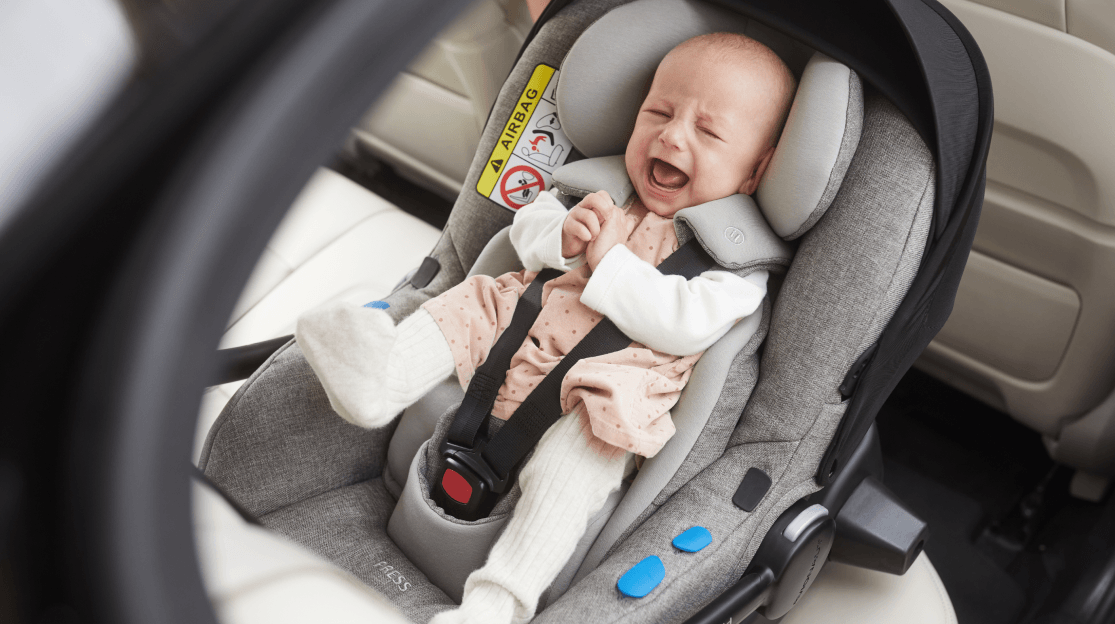
5 most common mistakes made when installing a child safety seat
A car seat is one of the most important elements of the starter kit for a newborn. Its purpose is to protect the health and life of a child in case of a more or less serious road traffic event. However, there is one condition: the car seat must be correctly fitted. Improper fitting may not only lead to improper use and discomfort for the child, but also put the child in a serious danger. What are the most common mistakes that parents make when fitting a child safety seat in their car? Check if you do not make them as well!

Contents:
- 1. RWF seat at the front + airbag activated
- 2. Seat inclination angle is too high
- 3. Twisted harness straps when installing the safety seat
- 4. Harness straps are too loose
- 5. Ignoring the carrycot handle when transporting the child safely
- How to install the car seat properly and avoid risks?
1. RWF seat at the front + airbag activated
We know that many parents like to keep an eye on their child while driving, especially if there is no other adult in the cockpit to supervise them. This leads to the child seat being transported on the front seat. Putting the child seat at this place is still disputable. Unfortunately, it is usually the front part of the vehicle that suffers the most during a traffic event, and this is a potential risk for the baby.
However, if for some reason, you are unable to transport a baby other than in the front seat and you use a rear-facing seat, be sure to deactivate the front passenger airbag. Its release in the event of a collision can seriously damage the seat which is extremely dangerous for your little passenger. However, if a child is in the forward-facing safety seat, the airbag should remain activated.
2. Seat inclination angle is too high
An overly angled seat usually causes the head of the baby to simply droop while sleeping. This is not only uncomfortable, but also dangerous for the baby. Remaining in this position for a long time can even lead to hypoxia.
3. Twisted harness straps when installing the safety seat
If you do not use an ISOFIX base but attach the child safety system to the car seat with the use of a standard belt, be sure to do this carefully. Incorrectly fitted belts, twisted in several places or mounted too loosely are common mistakes made by parents. As a result, the seat may fail to perform its function and move during sudden braking or another road event.
4. Harness straps are too loose
Even the safest child car seat available on the market will not work if it is fitted incorrectly. It is worth noting that a tightly fastened harness that supports the toddler in the seat is of great importance. The belt has to be fitted tightly to the child’s body – this is the basis for the correct use of each model. Therefore, during the winter months, children should not wear thick outerwear while being in a car seat. The thickness of such outerwear can make it difficult to properly tighten the harness straps. It is much better to cover the baby with a blanket or a special sleeping bag.
And how do you check that the harness has been properly tightened? Perform the ‘pinch test’. Insert your index finger between the harness and the chest of your child, then try to “pinch” the belt with your second hand. If you can catch it between two fingers, it means you need to improve the tightening.
5. Ignoring the carrycot handle when transporting the child safely
0–13 kg car seats have a dedicated handle with which we can move the carrycot from place to place with the baby inside. However, in addition to this, the handle may serve other purposes if specified by the manufacturer. Some parents neglect its importance completely and do not care about following the manual. This is a big mistake as the handle often has a seat stabilising function.
How to install the car seat properly and avoid risks?
The mistakes listed above are common, but at the same time simple to correct. All it takes is a little concentration when fitting the seat, and precise compliance with the manufacturer guidelines. How to minimise the risk of making mistakes when fitting the car seat?
- Choose the right child safety seat for your car. Make sure that the seat belts are not too short and that you can attach the seat correctly. In the case of models for infants, the angle of the backrest is also important – such babies still have low muscle tension and limited stabilisation in the neck area. When correctly fitted, the seat is inclined at an angle of approx. 45 degrees so that the child can travel in a safe position.
- If you happen to carry your child in a rearward-facing seat but on the front seat – always remember to deactivate the passenger airbag. All car brands provide for such an option. If you have an older car and are not sure whether the airbag can be deactivated, do not put your child in the front seat. This will let you avoid unnecessary risks.
- Always fasten the belt carefully, with the safety of your baby in mind. Do not do it carelessly, even if you have a short route ahead of you. Sometimes serious traffic events may occur really close to your home.
- Treat the base fixing with equal attention It should be as steady as possible and firmly attached to the seat. If the base has a signalling function so that you know whether all the parts have been correctly clipped in – do not underestimate it.
- Also read the manual on how to attach and use each seat. Just do it once and it will give you valuable information on safe travel for your child.
A car seat keeps your child safe, but only if it is fitted well. Pay attention to this in order to avoid mistakes that may have dangerous consequences. It is worth practising how to fit the car seat well. The more skilled you are, the less time you will need to fit the seat in accordance with the manufacturer guidelines.



